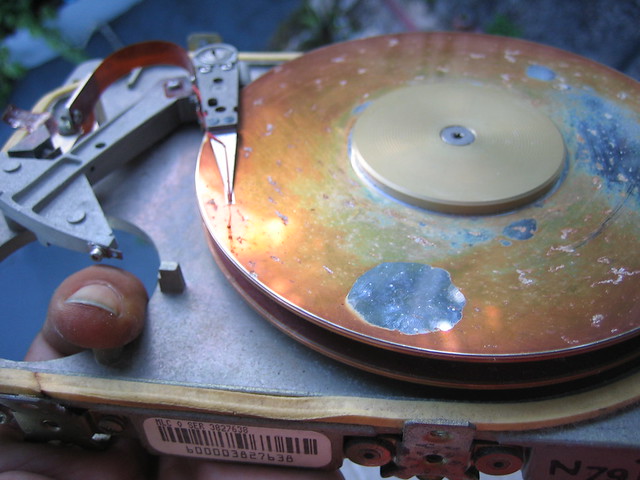How to set up a RAID 1 under GNU/Linux
This article explains how to set up a software RAID 1 (simple mirroring) under GNU/Linux with existing data.
Rationale: Let’s say you’ve got two hard drives of the same size and want to make some redundancy because the currently installed disk is starting to make scary noises. You know, that kind of “I’m gonna die soonish!” sound in hard drive parlance. Also, you don’t want to format this first drive so we’ll see how to build a RAID 1 array on our already running system without losing data or using a third drive.

This how-to should be suitable for any GNU/Linux distro (the only distro-specific step is explained for Fedora and Debian families).
First of all, let’s make sure we’ve got the package mdadm installed:
sudo yum install mdadm # or sudo apt-get install mdadm
sdd and sde will be the two drives that we’re going to use for our RAID.
sde is the one containing the existing precious data and sdd is the spare
drive with nothing important on it (it’ll be formatted). Bare in mind to adapt
it for your configuration if different.
Pro tip: An array of two drives can read in two different places at the same time. Therefore, to maximize performance benefits of RAID 1, you should use independent disk controllers, i.e. one for each disk.
Start by unmounting both drives to be sure they are not currently used:
sudo umount /dev/sd{d,e}?
The next step is to change the partition type to Linux raid autodetect for
every partition on sde.
sudo fdisk /dev/sde
[...]
Command (m for help): p
Disk /dev/sde: 1000.2 GB, 1000204886016 bytes
[...]
Device Boot Start End Blocks Id System
/dev/sde1 2048 1953523711 976760832 83 Linux
Command (m for help): t
Selected partition 1
Hex code (type L to list codes): fd
Changed system type of partition 1 to fd (Linux raid autodetect)
Command (m for help): w
The partition table has been altered!
Calling ioctl() to re-read partition table.
Syncing disks.
Then we can use sfdisk to copy the partition table from sde to sdd:
sudo sfdisk -d /dev/sde | sudo sfdisk /dev/sdd
Checking that no-one is using this disk right now ...
OK
Disk /dev/sdd: 121601 cylinders, 255 heads, 63 sectors/track
[...]
New situation:
Units = sectors of 512 bytes, counting from 0
Device Boot Start End #sectors Id System
/dev/sdd1 2048 1953523711 1953521664 fd Linux raid autodetect
/dev/sdd2 0 - 0 0 Empty
/dev/sdd3 0 - 0 0 Empty
/dev/sdd4 0 - 0 0 Empty
[...]
Check both hard drives have the same layout:
sudo fdisk -l /dev/sdd /dev/sde
Disk /dev/sdd: 1000.2 GB, 1000204886016 bytes
[...]
Device Boot Start End Blocks Id System
/dev/sdd1 2048 1953523711 976760832 fd Linux raid autodetect
Disk /dev/sde: 1000.2 GB, 1000204886016 bytes
[...]
Device Boot Start End Blocks Id System
/dev/sde1 2048 1953523711 976760832 fd Linux raid autodetect
Your might need to reset the superblock if the drive was used to be part of a RAID. But it doesn’t hurt to reset it anyway, you’ll just get this warning if it wasn’t necessary - no worries.
sudo mdadm --zero-superblock /dev/sdd1
mdadm: Unrecognised md component device - /dev/sdd1
Then, we create the actual RAID 1 using the placeholder missing for our
partition with existing data. That will allow us to mount it outside from the
RAID to copy our data onto the new RAID.
sudo mdadm --create /dev/md0 --level=1 --raid-disks=2 missing /dev/sdd1
mdadm: Note: this array has metadata at the start and
may not be suitable as a boot device. If you plan to
store '/boot' on this device please ensure that
your boot-loader understands md/v1.x metadata, or use
--metadata=0.90
Continue creating array? y
mdadm: Defaulting to version 1.2 metadata
mdadm: array /dev/md0 started.
Since my partition is a simple dumb “data” partition with no boot flag,
mdadm warns us but that’s fine in this case.
cat /proc/mdstat
Personalities : [raid1]
md0 : active raid1 sdd1[1]
976759672 blocks super 1.2 [2/1] [_U]
unused devices: <none>
Before we can actually use the RAID, we need to format it. I’ve chosen XFS here but you may want something else depending of your needs.
sudo mkfs.xfs -L data /dev/md0
[...]
Now, you need to create a new file to store your RAID configuration. Otherwise,
your OS will not know about it after reboot.
man 5 mdadm.conf should tell you its name but it’s usually /etc/mdadm.conf
on Fedora/CentOs/Redhat and /etc/mdadm/mdadm.conf on Debian/Ubuntu.
sudo mdadm --examine --scan | sudo tee /etc/mdadm.conf
ARRAY /dev/md/0 metadata=1.2 UUID=77b7054a:b48639d1:23b28664:597f5075 name=hostname:0
Now, we need to create a mount point for our RAID partition:
sudo mkdir /data
And add the appropriate line into /etc/fstab (bare in mind to adapt it for
your setup!):
sudoedit /etc/fstab
tail -1 /etc/fstab
/dev/md0 /data xfs defaults,nosuid,nodev 1 2
Mount it:
sudo mount -a
All right, just double check everything is fine before going any further. You should have something along these lines:
mount | grep md0
/dev/md0 on /data type xfs (rw,nosuid,nodev,relatime,seclabel,attr2,noquota)
cat /proc/mdstat
Personalities : [raid1]
md0 : active raid1 sdd1[1]
976759672 blocks super 1.2 [2/1] [_U]
unused devices: <none>
ls -lA /data
total 0
df -h /data
Filesystem Size Used Avail Use% Mounted on
/dev/md0 932G 33M 932G 1% /data
Now, we need a temporary mount point to copy data from sde to our freshly
formatted RAID:
mkdir /tmp/data
Although we’ve changed the partition type of sde1 to RAID, we can still mount
it as a regular file system.
sudo mount /dev/sde1 /tmp/data
Don’t forget this step. That is. DO NOT FORGET THIS STEP! I wasted one whole weekend recovering my data because I RTFM’d too fast and forgot this step. Sigh…
sudo rsync -av --progress /tmp/data/ /data/
Depending of how big is your disk, it’s going to take a while so you can monitor it in another terminal:
watch -d df -h /data /tmp/data # in another console
Filesystem Size Used Avail Use% Mounted on
/dev/md0 932G 5.9G 926G 1% /data
/dev/sde1 932G 914G 18G 99% /tmp/data
Go make you a coffee… If you have to interrupt the process half-way through, just hit Ctrl-C and you’ll be able to run rsync again later to finish transferring the missing files. rsync’s such a great tool! Personally, I had to do it over two days to copy the whole 932 gigs…
Finally all copied? Now you can unmount the partition.
sudo umount /dev/sde1
We’re going to add sde1 to our RAID array, let’s cat /proc/mdstat before:
cat /proc/mdstat
Personalities : [raid1]
md0 : active raid1 sdd1[1]
976759672 blocks super 1.2 [2/1] [_U]
unused devices: <none>
As soon as you enter the following command, your RAID should switch to recovery
mode and start mirroring files to sde1:
sudo mdadm --add /dev/md0 /dev/sde1
You can monitor it with /proc/mdstat. Once again, it can take ages (although
it should be slightly faster than the rsync step above). And once again, you
can reboot during the process as you wish, the recovery will resume
automagically until it reaches 100%.
watch -d cat /proc/mdstat
Personalities : [raid1]
md0 : active raid1 sde1[2] sdd1[1]
976759672 blocks super 1.2 [2/1] [_U]
[==>..................] recovery = 13.6% (133331328/976759672) finish=243.8min speed=57656K/sec
unused devices: <none>
If you experience a terribly slow speed, like 1000K/sec and it says it’ll take years to complete, you can force the recovery process to be faster with:
echo 100000 | sudo tee /proc/sys/dev/raid/speed_limit_min # 100M/sec
That way, the speed won’t be throttled any more (unless your drive can write faster than 100M/sec of course).
After a while, you should get something like this:
cat /proc/mdstat
Personalities : [raid1]
md0 : active raid1 sdd1[1] sde1[2]
976759672 blocks super 1.2 [2/2] [UU]
unused devices: <none>
Your RAID is up and running. Enjoy!
Now, when you hard drive will eventually die: just power off, replace it with a new one, reboot and wait for the recovery. You can simulate a disk failure with:
sudo mdadm /dev/md0 --fail /dev/sdX1 --remove /dev/sdX1
Obviously, you can do it the hard way too by physically unplugging the drive (or with a hammer and the like ;-)).
